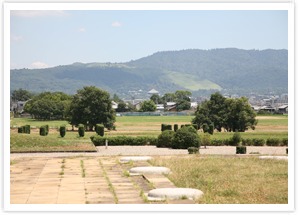The Ancient Japanese Nation and the Handicraft Industry

| Lecturer | Tomohiro FURUOYA, Professor |
|---|---|
| Department | School of Letters / Graduate School of Letters, 2011 Spring |
| Recommended for: | Students of School of Letters (2・1.5 hours / session One session / week 15 weeks / semester) |

Course Overview
In this course, through the methodology of document history, students will consider how ancient Japanese nation under the Ritsu-Ryo codes (ritsu=penal code, ryo=administration code) tried to control the handicraft industry as well as considering the parts of the industry that were not under the nation's control. Particularly, we will deal with the manufacture of roof tiles. First of all, the basic situation will be confirmed by reading ancient literatures such as the Ritsu-Ryo codes, the Rikkokushi (six books of ancient national history, e.g. A Record of Ancient Matters, 710), and the Shousou-in archives. Then we will analyze the roof tiles with incised or written characters excavated through archeological surveys. Characters incised with pallets on the tiles can be inscribed only before burning. Therefore according to what is written on the tiles, we can ascertain the production site. Based on the analyses of the incised tiles, we will investigate the questions about the roof tile industry both within and without the nation's control.
Key Feature
There are two main categories in the study of the past history: document history and archeology. Document history deals with documents written by people in the past, and in archeology we conduct research by surveying objects made and used by people in the past. To study the history of the handicraft industry, it is necessary to analyze the organization of people who made and used such objects and to look into the object itself. However, while, written documents can tell us about the people or the organization, what the actual products were will remain in the dark. Likewise, the archeological material, as an object to be investigated, does not tell us directly about the people who made it. The characters written on the object by the people who made it have the possibility to connect the two studies. In this course, through the application of the method of document history to roof-tiles with incised characters, we will analyze both the objects and people who made them, and understand the history of the handicraft industry.
Course Aims
Students are expected to achieve an understanding of how the ancient Japanese nation based on the Ritsu-Ryo codes was trying to control the handicraft industry, by examining the production of roof tiles.
Course Requirements and Recommended Courses
Basic knowledge of Japanese history learned in high school is required.
Assignments
Ex. Categorize different kinds of roof-tiles with incised or written characters referring to its system of production and supply.
Course Schedule
| Session | Contents |
|---|---|
| 1 | Introduction |
| 2 | 1 Precedent study of ancient history of manufacture 1 |
| 3 | 1 Precedent study of ancient history of manufacture 2 |
| 4 | 2 Documented manufacture of roof tiles 2-1 Construction of Asuka-dera temple and Transmission of technology |
| 5 | 2-2 Roof tile manufacture for palaces and official buildings 1 |
| 6 | 2-2 Roof tile manufacture for palaces and official buildings 2 |
| 7 | 2-3 Roof tile manufacture for temples |
| 8 | 3 Incised tiles and contribution 3-1 Some Categories of incised tiles 1 |
| 9 | 3-1 Some Categories of incised tiles 2 |
| 10 | 3-2 Roof-tiles with Incised or Written Characters of Kokubun-ji Temples of Eastern Japan 3-2-1 Ritsu-Ryo taxation system or contribution? |
| 11 | 3-2-2 Compulsory contribution 3-2-3 Summary |
| 12 | 3-3 Roof-tiles with Incised or Written Characters of Earthen Pagoda of Oonodera temple
3-3-1 Earthen Pagoda of Oonodera temple and excavated roof-tiles with characters |
| 13 | 3-3-2 Benefactors |
| 14 | 3-3-3 Analysis of the collection of Aichi Prefectural Ceramic Museum 3-3-4 Summary |
| 15 | Conclusion |
Assignments
Ex. Categorize different kinds of roof-tiles with incised or written characters referring to its system of production and supply.
Grading
The final exam at the end of the semester will verify student's understanding of how the ancient Ritsu-Ryo nation controlled the handicraft industry.
Last updated
May 08, 2020
